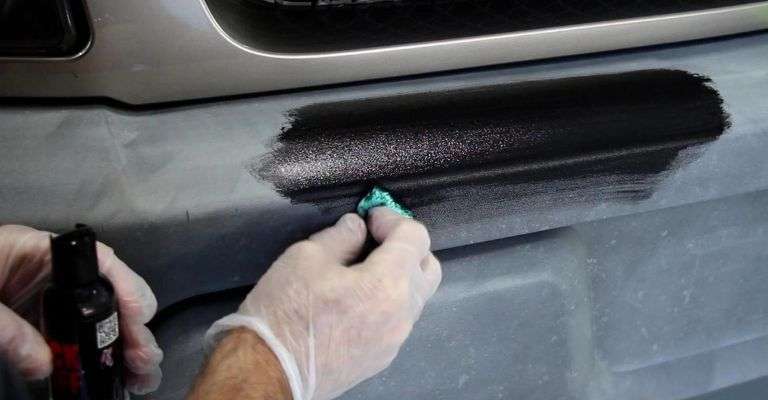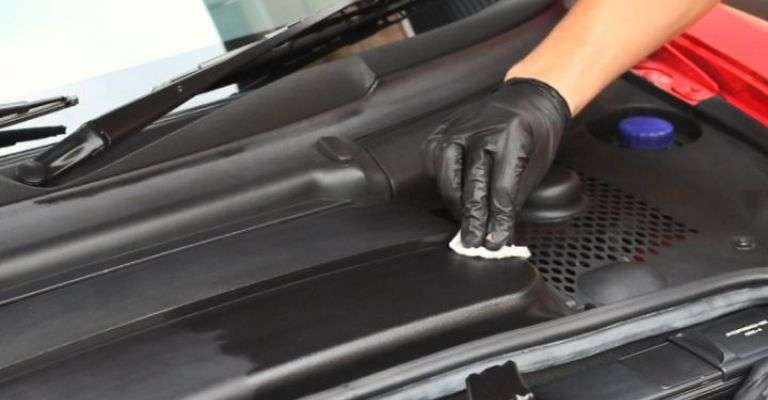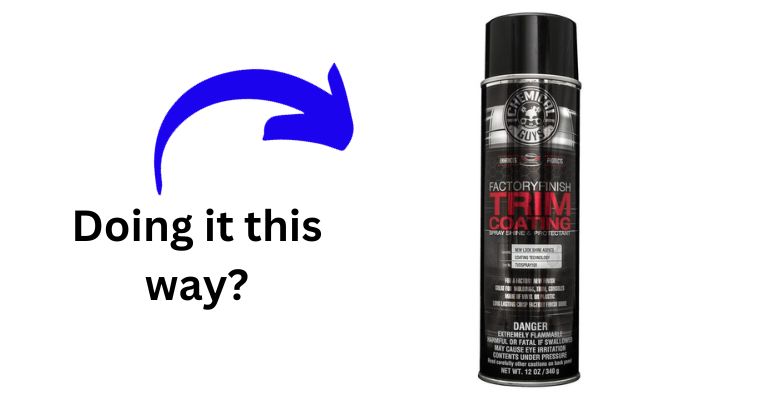Last Updated on September 22, 2023 by Chase Manhattan
If you own a car with plastic trim, you know how crucial it is to keep it in good condition. Over time, the elements can take a toll on your vehicle’s plastic trim, causing it to fade and lose its luster. This can detract from the overall look of your car and even lower its resale value. However, there’s good news.
- How to Clean Car Carpets Quickly (Without An Extractor) - July 10, 2024
- Can You Touch Up Clear Coat On A Car? Yes and No (Here’s Why) - November 25, 2023
- How To Wax A Car By Hand (For Beginners) - November 14, 2023
Revitalizing the plastic trim on your car is not as complicated as it might seem. With the right information, you can restore its original shine, giving your vehicle a fresh and well-maintained appearance. In this comprehensive guide, we will walk you through the process of restoring plastic trim on cars, providing practical steps and tips for effective restoration. Let’s get to it!
Understanding the Challenge
Before diving into the restoration process, it’s important to understand what causes plastic trim to deteriorate. The primary culprit is usually exposure to ultraviolet (UV) rays from the sun. These rays can oxidize the plastic, causing it to fade and turn a dull, chalky gray. Other factors, such as weathering and oxidation, can also contribute to the degradation of the trim. Over time, this can significantly impact the overall aesthetics of your vehicle, making it look older and less well-kept than it actually is.
Gathering Supplies
To start restoring plastic trim on cars, you’ll need to gather some essential supplies. These may include:
- A high-quality plastic trim restorer product
- Microfiber cloths for cleaning and buffing
- Masking tape to protect surrounding areas
- A heat gun (optional, for more advanced restoration methods)
Depending on the condition of your trim, you may not need all of these items. However, it’s always better to be prepared.

Restoring Plastic Trim on Cars: Step-By-Step Guide
- Preparation
- Clean the Area: Start by washing the plastic trim using a gentle soap and water. This removes any dirt, grime, or contaminants that might interfere with the restoration process. Use a soft cloth or brush to scrub gently.
- Dry Completely: Ensure that the trim is fully dry before proceeding. Use a clean microfiber cloth to wipe down the area.
- Assessment
- Inspect the Trim: Check the extent of the fading or damage. Look for scratches, scuffs, and other imperfections.
- Choose the Right Product
- Commercial Plastic Restorers: Opt for a reputable plastic restorer. They often contain ingredients that both restore the look of the trim and protect it from future fading.
- DIY Solutions: A popular homemade solution involves a mix of vinegar and linseed oil in equal parts. However, always test any DIY solution on a small, inconspicuous area first.
- Application
- Follow Instructions: If you’re using a commercial product, always read and follow the manufacturer’s instructions. Some products might require you to apply using circular motions, while others might have different specifications.
- Even Application: Ensure that the product is evenly distributed over the plastic trim. Uneven application can result in patchy or inconsistent results.
- Allow to Settle: Depending on the product, you might need to let it sit for a few minutes to a few hours.
- Buffing
- Use a Clean Cloth: Once the restorer has settled (or the stipulated time has elapsed), use a clean microfiber cloth to buff the trim gently. This helps in removing any excess product and brings out the shine.
- Protection (Optional but Recommended)
- Apply UV Protector: Sun damage is a primary cause of plastic trim fading. To prevent future fading, consider applying a UV protection spray or sealant.
- Regular Maintenance: Periodically clean the trim to prevent dirt buildup. Using specialized cleaning agents designed for car trims can help maintain the renewed look.
- Review & Repeat (If Necessary)
- Inspect the Results: Check the trim once you’re done. If it’s not to your satisfaction, you might need to repeat the process or leave the restorer on for a longer duration.
With regular care and the occasional touch-up, your car’s plastic trim can continue to look as good as new!
If you prefer a visual format, check this out:
[su_youtube_advanced url=”https://www.youtube.com/watch?v=3AS8QFUQkJs”]

Protecting and Maintaining
Once you’ve restored your plastic trim, it’s important to protect it from future damage. Here’s a step-by-step guide for maintenance and protection after your plastic has been restored:
- Regular Cleaning:
- Use a gentle automotive soap and water solution to clean the trim periodically. This prevents dirt and grime buildup which can lead to premature fading or discoloration.
- UV Protection:
- Sun exposure is a leading cause of trim fading. Ensure you apply a UV protection spray or sealant specifically designed for car trim to safeguard against harmful ultraviolet rays.
- Avoid Harsh Chemicals:
- When cleaning the rest of your vehicle, be cautious about chemical overspray or spillage on the plastic trim. Avoid harsh detergents or solvents that could degrade the plastic or its protective sealant.
- Regular Inspections:
- Periodically inspect the trim for signs of wear, damage, or fading. Addressing issues early can prevent more significant problems down the road.
- Park Smartly:
- Whenever possible, park in shaded areas or use a car cover to protect the trim (and the entire vehicle) from direct sunlight and environmental contaminants.
- Re-apply Protective Products:
- Over time, protective sealants or UV protectors might wear off. Based on the product’s recommendations, reapply it periodically to maintain optimal protection.
- Limit Physical Damage:
- Be mindful when loading or unloading items near the trim to avoid scratches or dings. Consider using edge guards if your vehicle’s trim is susceptible to damage in parking lots or tight spaces.
- Stay Informed:
- New products and techniques for maintaining automotive plastics are continually emerging. Stay updated by occasionally researching or talking to professionals about the latest best practices.
- Hydration is Key:
- Just as our skin needs moisturization, plastic can benefit from occasional treatments with products designed to hydrate and replenish its look. These can prevent it from becoming brittle or showing age.
- Seek Professional Advice:
- If unsure about a product or procedure, consult with a car detailing professional. They can provide insights based on your specific vehicle and its needs.
By adhering to these good practices, you can ensure that your restored plastic trim remains in peak condition for years to come.
DIY vs. Professional Restoration
While restoring plastic trim on cars can be a DIY project, you may also consider hiring a professional. Professional restoration services typically offer a higher level of expertise and can often achieve better results. However, they can also be more costly and time-consuming. If you’re confident in your abilities and have the necessary tools and materials, you can achieve excellent results by doing the job yourself.
Troubleshooting Common Issues
During the restoration process, you may encounter some common problems. For instance, you might notice streaks or uneven application of the restorer product. If this happens, try applying a lighter coat and buffing it more thoroughly. If you notice any product residue, you can usually remove it with a clean, dry microfiber cloth. If you’re having trouble, don’t hesitate to seek advice from a professional or consult online resources for help.
Final Thoughts
Restoring plastic trim on cars can be a rewarding project that significantly enhances the look and value of your vehicle. By taking the time to properly clean, restore, and protect your trim, you can keep your car looking its best for years to come. Whether you choose to tackle this project yourself or hire a professional, the results can be well worth the effort.
Conclusion
Thank you for taking the time to learn about restoring plastic trim on cars. We hope this guide has provided you with valuable information and practical tips for tackling this project. Remember, with the right knowledge and tools, you can restore the shine and brilliance of your car’s plastic trim, enhancing its aesthetic appeal and longevity. For more car care tips and advice, feel free to explore our other articles and resources.



